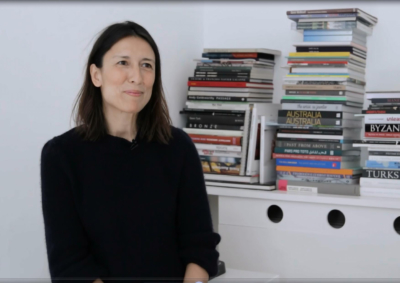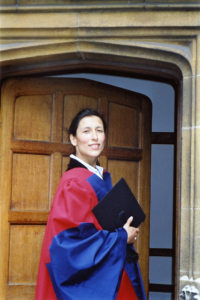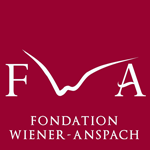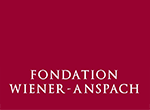 Danièle Reiber is the founder and director of Reiber PR, a public relations company operating in the arts world. She graduated from the ULB, but her passion for musicology – together with a Wiener-Anspach fellowship in 1994/1995 – made her cross the Channel over twenty years ago.
Danièle Reiber is the founder and director of Reiber PR, a public relations company operating in the arts world. She graduated from the ULB, but her passion for musicology – together with a Wiener-Anspach fellowship in 1994/1995 – made her cross the Channel over twenty years ago.
Danièle, who has granted us a fascinating interview for our 2019 Activity Report, was also recently interviewed by the Belgian newspaper L’Echo (article available online).
What prompted you to study musicology at the ULB?
Music has been an important part of my life since the age of ten, when I started playing the piano, and has definitely influenced my choice of studies. At the time I was equally interested in the history of art and the history of music, and nurtured interdisciplinarity, the way the arts would connect with one another and mirror society. When I realised I could take some history of art modules as part of the musicology course, I didn’t hesitate.
After obtaining your degree at the ULB in 1992, you started a PhD in musicology and spent a year in Oxford as an Erasmus student. Why Oxford?
As an Erasmus student I was given the choice between Boston or Oxford, and I knew I wanted to write about Mahler. It was a hard choice. After careful consideration, I chose Oxford as I wasn’t ready to live in the US. This is when I met Dr Bojan Bujic, my first tutor at the Oxford Music Faculty. Because of his cultural background (he was born in Sarajevo), rooted in the rich history of the Habsburg Empire, he instantly responded to Mahler, to the broader topic of fin de siècle Vienna and to the socio-cultural route I was intending to take in my research.
In 1994, you applied for a Wiener-Anspach fellowship to return to Oxford within the framework of your PhD.
Yes, I applied with the support of Dr Bujic and this has had an enormous impact on the course of my life. Applying to a fellowship is one thing, being selected is another but the fundamental step – and you never realise it when you apply – is the impact that this experience will have on your life.
Two other academics guided you during this second research stay in Oxford: Prof. Parker and Prof. Franklin. What are your memories of them?
Roger Parker was a very charismatic tutor, providing a wealth of knowledge at all levels, with specific expertise in opera. While his field of interest was miles away from mine, I learnt a huge amount from him on a personal level: his classes were very dynamic, he would challenge students, encourage them to build up arguments and voice their opinion, and reflect upon them critically. It was both exciting and intimidating for a student like me, more reserved, used to a different teaching system and more comfortable with written expression. And then Prof. Franklin who arrived from Leeds University… a dream come true. Not only was he a reputed specialist in late 19thC symphonic music but also wrote extensively on Mahler. He was an incredibly warm, sensitive and inspiring mentor. I am forever grateful to all three.
Your doctoral dissertation was entitled «From Utopia to anti- Utopia: the narrative journey of Mahler’s Fourth Symphony». What did you wish to bring to light in this work?
As mentioned earlier I have always been interested in how art reflects society; the way painting or music can mirror the zeitgeist through very defined semiotic patterns. My thesis provided a socio-cultural reading of Mahler’s music, more specifically the Fourth Symphony, which unlike his other more grandiose or darker symphonies, takes us to a whole different world – that of the ‘child’. The child-like innocence that pervades the entire work, continuously disrupted by bursts of irony and a frightening loss of direction, is deceptive and ominous; the anti-utopian discourse is verified in the unsettling song in the finale – ‘the child’s vision of heaven’ – that brings no resolution, a mere disconcerting ‘laughter’ shattering the hope and innocence suggested in the earlier movements. It was fascinating to be able to use the work’s broader socio-cultural context to decipher its content and the images emanating from it; and to identify a specific lexicon proper to fin de siècle Vienna that would also transpire in Gustav Klimt’s paintings, Robert Musil’s novels or Sigmund Freud’s psychoanalysis. My thesis was not meant to provide conclusive answers. Like Mahler’s Fourth Symphony, it ends on a question mark.
Soon after completing your PhD, you founded a public relations company operating in the art world. How did this professional project originate?
Like all PhD students, opportunities to teach after graduation came up, but I was never attracted to academia as such. I was more interested in connecting with the exciting world of arts more broadly. While in Oxford, I took real pleasure in organising a series of conferences on Mahler, inviting leading figures from the world of art and music, as well as members of his family, to come and speak. It was extremely rewarding and revealing of the type of work I enjoyed. When I arrived in London in 1998, the Labour party was in full force, funding for the arts was like never before, museums were investing and opening new extensions, job opportunities in the cultural sector were endless. London was the perfect propelling platform for someone like me, eager to put my entrepreneurial spirit at work, loving to communicate and bringing people together. I then married the Head of Press at the National Portrait Gallery. After several press campaigns for the museum, the Royal Academy of Arts, the Victoria and Albert Museum, the British Museum, the National Gallery all heard of my work and asked for my services. The business took off rapidly. I opened my first office on Savile Row in Mayfair. I was blessed to have such a prestigious address. I kept a relatively small team for a while, concentrating primarily on European press services. Then I strengthened our offer to include the UK, US, Asia, Latin America and expanded the team. Today our team is made of ten incredible multilingual professionals and we promote small to large-scale cultural events across the commercial and non-profit sectors, working with artists, galleries, museums, foundations, biennials and fairs internationally.
 What were the milestones in these twenty years?
What were the milestones in these twenty years?
Because of the company’s unique business model, i.e. boutique in size, flexible and adaptable, and distinct in its approach, we have managed to thrive over the past twenty years despite the recession of 2008 that hit a lot of art businesses. Our agency has the capacity to grow or downsize if need be. I have opted to keep the business mid-size, however, to ensure its smooth and sustained cruising speed over time. With the ever fluctuating political and economic climate, I prefer not to take risks. In terms of milestones, private clients such as Fondazione Prada in Milan or Fondation Cartier in Paris, along with major London-based museums, have helped position the agency amongst the leading ones in Europe. We don’t only promote exhibitions but also work on corporate communications and are regularly approached by major institutions to take care of their development projects, anniversaries and other landmark events. The rise of the art market over the last fifteen years has also helped art PR companies thrive financially but our work remains primarily focused on the non-profit sector. I see more relevance in supporting their initiatives.
And today, what are the main challenges in your industry?
The main challenge is to keep the offering fresh and high- end at all times, and ensure it remains distinct from others as competition grows rapidly. A recent challenge has been to adapt to the digital world and include digital marketing as part of our services. Most of our clients are aged 50 and over and still appreciative of traditional PR. But there is the new generation of clients, younger, tech-savvy and hungry for wide digital exposure that we needed to cater for, so we have had to equip ourselves accordingly. Today this is what we enjoy most: working on exciting rich media content including podcasts, videos and social media plans.
What do you think are the current trends in your sector?
Broadly speaking, I would say that common concerns such as the place of women in society, race equality, the importance of ethics, human rights and environmental awareness have all impacted on our sector. As an agency we have to behave ethically and remain cautious about the type of clients we take on board; the art world and more specifically the market for art is very opaque, and companies and clients are under scrutiny all the time. We also undertake more and more projects addressing gender and race equality. An example is the rise of African art. The same goes for the place and voice of women in the arts, alongside feminist discourses which pervade a lot of our projects. With regards to the environment, it is wonderful to see so many organisations, artists, designers, curators engaging in climate, environmental and human rights issues and adopting a radically green approach to art and art making. Additional trends and topics embraced by my industry include philanthropy and a return to craftmanship and timeless values in art and design.
Could Brexit affect your activities?
Brexit has not affected our business so far and we know very little about the months ahead. I would say that London has been a fertile ground for art PR agencies for decades, with clients from all over Europe and the US buying our services. Objectively the network and level of PR services in our field is stronger in the UK than anywhere else in Europe, and I just hope Brexit won’t lure foreign clients away. With the current rise of nationalism that we are facing globally, we might see a form of withdrawal on their part; PR agencies in continental Europe might strengthen their offering and create a more local market, attractive enough to local clients. This is why having a distinct signature is key to success.
In 2018 you opened an office in Brussels. Does this confirm the importance gained by the Belgian capital on the European contemporary art scene?
The opening of our outpost in Brussels is more coincidental than a deliberate choice. With Brexit looming, one of my associates had to relocate in Brussels. I seized the opportunity to look back at my hometown, explore potential avenues for new business and reconnect with my roots. In twenty years, Belgium has undoubtedly shaped up into an exciting and vibrant city for culture. With the power to erase all linguistic divides, the arts have had an incredible uniting effect on artistic communities, creating more fluidity between regions, encouraging joint initiatives between institutions etc. Art and design fairs provide further support to these forms of collaborations. With the help and determination of key players in the field as well as increased private funding, the country has really positioned itself among the most exciting destinations for art and culture in Europe.
Did you stay in touch with people from your Oxford years?
I am still in touch with old friends from Oxford, some live in London, some abroad. I recently went back with my son to attend a conference. I was moved to the core, remembering how happy I was in Oxford and blessed to have been given the opportunity to study there. I also got married at Magdalen College, in its gorgeous chapel filled with the magical voices of Magdalen College Choir, so Oxford will forever remain associated with incredibly fulfilling moments in my life.
One last question to close the loop on this interview… What role does music play in your life today?
Music is my passion. Whether playing, dancing or listening to it, it continues to bring the same joy and emotions. It is the beautiful garden where I can safely retreat.


